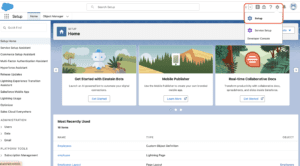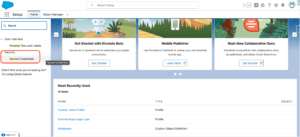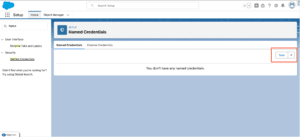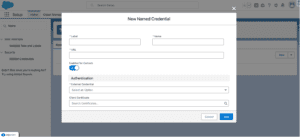In our previous blog post we had discussed about How to Authentication in Salesforce. In these blog post we discuss about What is Name Credentials in Salesforce
Contents
- 1 Introduction
- 2 Understanding Salesforce Name Credentials
- 3 Why Use Name Credentials?
- 4 Setting Up Name Credentials in Salesforce
- 5 Configuring Named Credentials
- 6 Testing and Validation
- 7 Using Named Credentials with External Services
- 8 Advanced Configurations
- 9 Best Practices
- 10 Common Pitfalls and How to Avoid Them
- 11 Monitoring and Managing Named Credentials
- 12 Case Studies
- 13 Future Trends in Salesforce Authentication
- 14 Conclusion
- 15 FAQs
What is Name Credentials in Salesforce
Introduction
Have you ever struggled with managing authentication for various external services in Salesforce? If so, you’re not alone. Name Credentials are a powerful feature in Salesforce that simplifies this process, making it easier to integrate and authenticate with external systems. In this article, we’ll dive deep into what Name Credentials are, why they’re important, and how you can set them up and use them effectively.
Understanding Salesforce Name Credentials
Definition and Purpose
Name Credentials in Salesforce are a way to store and manage authentication settings for external services. They provide a secure and straightforward method to integrate with APIs and other external systems without having to handle the complexities of authentication manually.
Key Components
The key components of Name Credentials include:
- Authentication Protocols: Methods like OAuth, JWT, and Basic Authentication.
- Endpoint URLs: The URLs of the external services you want to connect to.
- Custom Headers: Additional headers required for authentication.
Why Use Name Credentials?
Simplifying Authentication
Using Name Credentials simplifies the process of authenticating with external services. You no longer need to write complex code to handle different authentication methods; instead, Salesforce handles it for you.
Enhancing Security
Name Credentials enhance security by storing sensitive information in a secure manner within Salesforce. This reduces the risk of exposing credentials and ensures that your integrations are safe.
Setting Up Name Credentials in Salesforce
Prerequisites
Before setting up Name Credentials, ensure that you have:
- Proper access permissions in Salesforce.
- The necessary authentication details for the external service.
Step-by-Step Guide
- Navigate to Setup: Go to the Salesforce Setup menu.
- Search for Name Credentials: Use the Quick Find box to search for “Name Credentials.”
- Create New Name Credential: Click on “New Name Credential.”
- Enter Details: Fill in the required fields such as Name, URL, and Authentication settings.
- Save: Click “Save” to create the Name Credential.
Configuring Named Credentials
Creating Named Credentials
To create Named Credentials:
Go to Setup.

Enter “Name Credentials” in the Quick Find box.

Click “New Name Credential.”

Enter a name and the endpoint URL.

Choose the authentication protocol.
Save your settings.
Authentication Protocols
Salesforce supports various authentication protocols such as:
- OAuth 2.0: For secure token-based authentication.
- JWT: For JSON Web Token authentication.
- Basic Authentication: For simple username and password authentication.
Testing and Validation
Ensuring Correct Configuration
After setting up Name Credentials, it’s crucial to test them to ensure they’re configured correctly. You can do this by:
- Making test API calls.
- Checking the response for any errors.
Common Issues and Fixes
Some common issues include:
- Incorrect endpoint URLs.
- Misconfigured authentication settings.
- Missing permissions.
To fix these issues, double-check your settings and ensure that all required fields are correctly filled.
Using Named Credentials with External Services
Integrating with APIs
Named Credentials can be used to integrate with various APIs. For example, you can connect to:
- REST APIs: For accessing web services.
- SOAP APIs: For more traditional web services.
Real-World Examples
Here are some real-world examples of using Named Credentials:
- Integrating Salesforce with Google Maps API for location services.
- Connecting to a third-party CRM system for data synchronization.
Advanced Configurations
Custom Headers
Sometimes, external services require custom headers for authentication. With Named Credentials, you can add these headers easily during configuration.
Token Refresh Mechanisms
For OAuth-based authentication, you may need to handle token refreshes. Salesforce allows you to configure token refresh mechanisms to ensure continuous access.
Best Practices
Security Tips
To ensure the security of your Name Credentials:
- Regularly update your credentials.
- Use secure authentication protocols.
- Limit access to sensitive credentials.
Maintenance Strategies
Regularly review and update your Name Credentials to ensure they remain secure and functional. This includes:
- Auditing credentials periodically.
- Removing unused credentials.
Common Pitfalls and How to Avoid Them
Misconfigurations
Misconfigurations can lead to failed integrations. Avoid this by carefully following setup instructions and double-checking your settings.
Troubleshooting Tips
If you encounter issues:
- Check the Salesforce logs for error messages.
- Verify your authentication settings.
- Ensure you have the necessary permissions.
Monitoring and Managing Named Credentials
Regular Audits
Conduct regular audits to ensure your Named Credentials are secure and up-to-date. This helps in identifying and addressing potential security risks.
Performance Metrics
Monitor the performance of your Named Credentials to ensure they are functioning efficiently. This includes tracking response times and error rates.
Case Studies
Success Stories
Many organizations have successfully used Named Credentials to streamline their integrations. For example, a retail company used Named Credentials to connect Salesforce with their inventory management system, resulting in improved efficiency and accuracy.
Lessons Learned
Through various implementations, companies have learned the importance of:
- Proper planning before setup.
- Regular maintenance and updates.
- Thorough testing before deployment.
Future Trends in Salesforce Authentication
Evolving Technologies
As technology evolves, so do authentication methods. Future trends in Salesforce authentication may include:
- Enhanced AI-driven security measures.
- More robust multi-factor authentication methods.
Predictions
The future of Salesforce authentication looks promising, with more automated and intelligent security solutions on the horizon.
Conclusion
Name Credentials in Salesforce provide a secure and efficient way to manage authentication for external services. By simplifying the authentication process, enhancing security, and offering robust integration capabilities, they are an invaluable tool for any Salesforce administrator. Remember to follow best practices, regularly audit your credentials, and stay updated with the latest trends to make the most of this powerful feature.
We Want more about What is Name Credentials in Salesforce Click Here
FAQs
1. What are Name Credentials?
Name Credentials in Salesforce are a way to store and manage authentication settings for external services securely.
2. How secure are Name Credentials?
Name Credentials enhance security by securely storing sensitive information and handling authentication within Salesforce.
3. Can Name Credentials be used with any API?
Yes, Name Credentials can be used with various APIs, including REST and SOAP APIs.
4. What are the best practices for managing Name Credentials?
Best practices include regularly updating credentials, using secure authentication protocols, and conducting regular audits.
5. How do I troubleshoot common issues with Name Credentials?
To troubleshoot issues, check the Salesforce logs for errors, verify authentication settings, and ensure necessary permissions are in place.
In our next blog post we will discuss about How to Whitelist IP Address in Salesforce

2 thoughts on “What is Name Credentials in Salesforce”